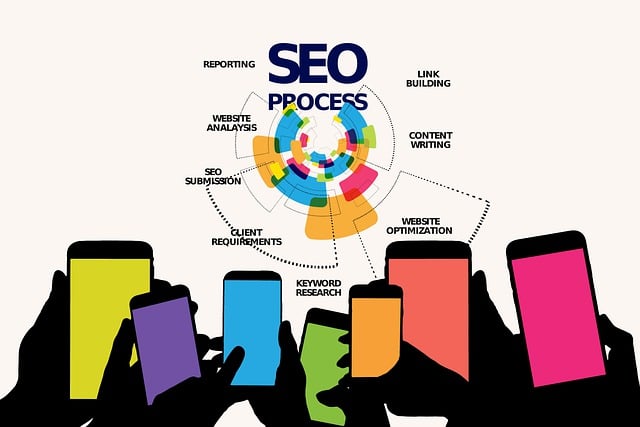White-Hat SEO focuses on ethical, sustainable practices for online success. By prioritizing quality content, mobile optimization, organic backlinking, and structured data, these techniques build long-term authority and avoid search engine penalties. Strategic keyword research identifies high-value terms aligned with user intent, guiding content strategy. On-page optimization includes integrated keywords in titles, headings, and meta descriptions, with a focus on unique, engaging content for enhanced user experience. Building high-quality backlinks from authoritative sources signals search engines of valuable content. Technical considerations optimize website structure, loading speeds, and mobile friendliness for better user navigation and engagement. Constant monitoring of algorithms and trends is crucial for adapting White-Hat SEO strategies.
Professional White-Hat SEO is a strategic approach designed to elevate online visibility while upholding search engine guidelines. This article delves into essential components of effective White-Hat SEO techniques, guiding businesses towards sustainable growth. We explore foundational principles, beginning with understanding the core concepts and evolving through crucial practices like keyword research, on-page optimization, high-quality content creation, and link profile building. Technical SEO considerations and continuous monitoring round out this comprehensive guide for mastering proven White-Hat SEO strategies.
Understanding White-Hat SEO Principles

White-Hat SEO refers to a set of ethical and sustainable practices aimed at improving search engine rankings while adhering to search engine guidelines. It emphasizes quality content, user experience, and legitimate methods to ensure long-term success in online visibility. Unlike Black-Hat SEO, which employs aggressive and deceptive tactics, White-Hat techniques focus on building a solid foundation for a website’s online presence.
Understanding these principles is crucial for professionals as it enables them to implement effective strategies that not only boost search rankings but also enhance user engagement. Key White-Hat SEO techniques include optimizing content for relevant keywords, ensuring mobile-friendliness, creating high-quality backlinks through organic means, and implementing structured data markup to provide rich snippets in search results. These practices contribute to a website’s authority and visibility while avoiding penalties that can be levied by search engines against sites employing manipulative or spammy tactics.
Keyword Research: A Cornerstone of Success

Keyword research is a fundamental and critical aspect of successful White-Hat SEO techniques. It involves identifying relevant, high-value keywords that potential customers are using to search for products or services similar to yours. By understanding user intent and searching patterns, businesses can create content that resonates with their target audience. This strategic approach ensures that online visibility is not just about attracting any traffic but quality visitors who are genuinely interested in what the website offers.
Effective keyword research provides valuable insights into competitors’ strategies, market trends, and user preferences. It involves tools and techniques to analyze search volume, competition, and user behavior. This data-driven approach enables SEO professionals to make informed decisions about content creation, optimization, and overall digital marketing strategy.
On-Page Optimization Strategies

White-Hat SEO Techniques focus on on-page optimization strategies that enhance search engine visibility while adhering to best practices and guidelines. This involves optimizing key elements within a website’s code, structure, and content to improve user experience and relevance for target keywords. One crucial aspect is keyword research, where relevant terms are identified and strategically incorporated into titles, headings, meta descriptions, and body text. Another vital strategy is ensuring proper header tags (H1-H6) hierarchy and alt image tags for better indexation.
Content optimization plays a significant role in White-Hat SEO. This includes creating high-quality, unique content that provides value to visitors, as well as using internal linking to improve site navigation and distribute page authority. Additionally, optimizing load speeds by compressing images and leveraging browser caching ensures fast page loading times, enhancing both user experience and search engine rankings.
High-Quality Content Creation

In the realm of White-Hat SEO Techniques, high-quality content creation is a cornerstone that drives organic search rankings and fosters user engagement. It involves crafting well-researched, informative, and unique pieces that cater to both search engines and human readers. Professional SEO practitioners recognize that content is not merely text; it includes optimized meta titles, descriptive headers, and strategic keyword placement—all while maintaining readability and relevance.
This meticulous approach ensures that websites offer valuable insights, addressing user queries comprehensively. High-quality content also encourages social sharing, increases time spent on pages, and reduces bounce rates—key signals that search engines use to assess a site’s authority and relevance. By prioritizing these White-Hat SEO Techniques, businesses can attract and retain audiences, ultimately achieving long-term success in the competitive digital landscape.
Building Strategic Link Profiles

Building strategic link profiles is a cornerstone of effective White-Hat SEO Techniques. It involves cultivating high-quality backlinks from reputable sources, which signals to search engines that your website offers valuable content meriting top rankings. This process requires a thoughtful approach, focusing on earning links through organic means such as creating exceptional content, engaging in industry partnerships, and contributing to thought leadership discussions.
By diversifying link sources—including blogs, news outlets, and educational platforms—you establish a robust profile that enhances your website’s authority. Avoiding low-quality or spammy links is crucial, as they can negatively impact your search engine rankings. Instead, focus on building relationships with influential websites in your niche, offering valuable content exchanges, guest blogging opportunities, and collaborative projects that naturally attract backlinks.
Technical SEO Considerations

In the realm of White-Hat SEO Techniques, Technical SEO Considerations play a pivotal role in enhancing online visibility and user experience. These include optimizing website structure, ensuring fast loading times, implementing structured data markup, and creating a mobile-friendly design. A well-structured site with efficient navigation allows search engines to crawl and index pages effortlessly, leading to better rankings.
Additionally, addressing technical aspects like improving site security (HTTPS), fixing broken links, and utilizing XML sitemaps aids in maintaining a healthy website infrastructure. These practices not only contribute to better search engine understanding but also foster a seamless user journey, encouraging visitors to explore more, thereby reducing bounce rates and increasing engagement.
Continuous Monitoring and Adaptation

In the dynamic landscape of online search, continuous monitoring and adaptation are vital components of successful White-Hat SEO techniques. Professionals in this field must stay abreast of evolving search engine algorithms, user preferences, and market trends to ensure their strategies remain effective. Regular analysis of website performance data allows for informed decisions on optimizing content, refining meta tags, and improving site speed—all crucial aspects for boosting search rankings.
By adopting a proactive approach, SEO experts can identify emerging opportunities and address potential threats promptly. This involves staying updated on industry news, competitor moves, and algorithm updates from major search engines like Google. Through continuous monitoring, professionals can adapt their techniques, ensuring their websites remain competitive, user-friendly, and aligned with the latest best practices in White-Hat SEO.
